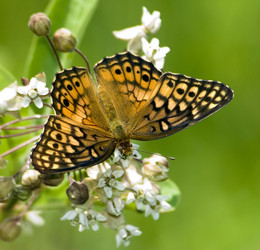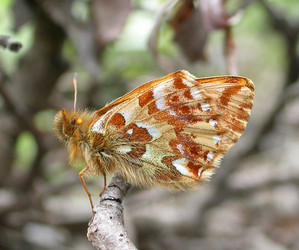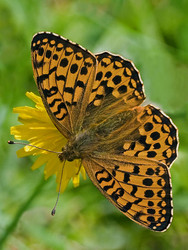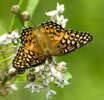Argynnini
Fritillaries
Thomas Simonsen, Niklas Wahlberg, and Andrew V. Z. Brower


This tree diagram shows the relationships between several groups of organisms.
The root of the current tree connects the organisms featured in this tree to their containing group and the rest of the Tree of Life. The basal branching point in the tree represents the ancestor of the other groups in the tree. This ancestor diversified over time into several descendent subgroups, which are represented as internal nodes and terminal taxa to the right.

You can click on the root to travel down the Tree of Life all the way to the root of all Life, and you can click on the names of descendent subgroups to travel up the Tree of Life all the way to individual species.
For more information on ToL tree formatting, please see Interpreting the Tree or Classification. To learn more about phylogenetic trees, please visit our Phylogenetic Biology pages.
close boxIntroduction
The tribe Argynnini, commonly known as Fritillaries, is a group of fairly uniform, small to medium sized butterflies. Almost all species have an orange-brown ground colour with a pattern of black spots and streaks on the upper side, and some pearly white to silvery white spots on the underside, particularly on the hindwing.
Classically, the Argynnini has been divided into as many as 17 genera, but here we follow Simonsen (2006b) and Simonsen et al. (2006) and reduce the number of "traditional" argynnine genera to six. In addition, we include the enigmatic monotypic African genus Pardopsis (formerly viewed as a member of Acraeini), based on the recent molecular results of Silva-Brandão et al. (2008). At the moment, no morphological characters support the inclusion of Pardopsis in Argynnini. The exact number of species in the tribe is uncertain. On the Tree of Life, we tentatively list 105 species. But this number is highly uncertain and may change dramatically with forthcoming revisions of the species-rich and taxonomically insufficiently known genus Boloria and the Argynnis subgenus Speyeria.
Most Argynnini species are distributed in the temperate, alpine and arctic regions of the Holarctic. The genus Yramea is endemic to south temperate and Andean South America, while Euptoieta is a truly "neotropical" genus, with one species (Euptoieta claudia) that also extends well into temperate North America.
Characteristics
Putative autapomorphies for Argynnini (excluding Pardopsis) include (Penz & Peggie 2003, Simonsen 2006a, b):
- Arch formed by tegumen and pedunculi smaller than arch formed by vinculum and saccus
- Antero-basal sulcus on the outer surface of the male valve
- Male tegumen with small latero-ventral sclerite
- Male valve with crista interior
- Female foreleg tarsomers with few sensilla
Putative synapomorphies for Yramea , Boloria , Argynnina (modified from Simonsen 2006b):
- Juxta halves connected by a membranous collar
- Female abdominal S7 posteriorly with thick setae
- Female abdominal venter 8 broad
- Venter 8 dorsally as long as T8
- Hind wing humeral vein straight
Putative synapomorphies for Boloria , Argynnina (modified from Simonsen 2006b):
- Valve with a pointed terminal tip
- Valve with a dorso-posterior tuft of long, stout, dense setae
- Female abdominal venter 8 with transverse, sclerotized, ventral ridges.
Putative autapomorphies for Argynnina include (Simonsen 2006a, b):
- Crista on the male valve serrate
- Harp fold on the valve is long
- Harp fold with a thump-like anterior process
- Internal glandular pocket of the male valve with a well-developed closing mechanism
- Cuticular wall of the internal glandular pocket thin
- Glandular epithelium of the internal pocket thin-layered
- The phallus bilateral assymetric
- Forewing vein Rs3 arising beyond the end of Rs1
Putative synapomorphies for Brenthis , Argynnis (Simonsen 2006b):
- Phallus with centro-dorsal cross bridge
- Intersegmental membrane between female segment A8 and anal papilla without a patch of dense, pale pilliform scales
- Hind wing humeral vein curved towards the tip of the wing
Notes: The genus-level phylogeny shown here is derived from Simonsen et al. (2006) and differs from the morphological study by Simonsen (2006b) by having Yramea as the sister group of Boloria + Argynnina, instead of having Yramea + Boloria as the sister group of Argynnina. The putative synapomorphies for Yramea , Boloria , Argynnina and Boloria , and Argynnina, respectively, are therefore not directly from Simonsen (2006b), but identified by analyzing the morphological characters therein against the phylogenetic relationships recovered by the combined morphological + molecular analysis in Simonsen et al. (2006).
Discussion of Phylogenetic Relationships
The classification and systematic relationships of the Argynnini has been the subject of numerous studies for more than three-quarters of a century, based on both morphology (Reuss 1926, Dos Passos & Grey 1945, Warren et al. 1946, Warren 1955, Shirôzu & Saigusa 1973, Penz & Peggie 2003, Simonsen 2006a, b) and molecular characters (Aubert et al. 1996, Simonsen et al. 2006). Simonsen et al. (2006) is so far the only study that has combined morphological characters with a large molecular dataset including several gene regions.
The tribe Argynnini is comprised by four subtribes: Euptoietina Simonsen, 2006 (comprising Euptoieta), Yrameina Reuss, 1926 (comprising Yramea), Boloriina Warren et al., 1946 (comprising Boloria) and Argynnina (comprising Issoria, Brenthis and Argynnis s.l.). The position of Euptoieta has been disputed, and it was placed within Heliconiinae by Harvey (1991) without a specific tribal or subtribal assignment. Recent studies (Brower 2000, Penz & Peggie 2003, Freitas & Brown 2004, Simonsen 2006a, b, Simonsen et al. 2006) have all placed Euptoieta with the fritillaries. Penz & Peggie (2003), in a study focussed on the entire subfamily Heliconiinae, placed Euptoieta as the sister group of Argynnina. However, Simonsen (2006b) and Simonsen et al. (2006) in studies focussed on Argynnina favoured the shown phylogeny with Euptoietina as a separate subtribe comprising the sister group of the remaining fritillaries.
The positions of Yramea and Boloria have been disputed as well. Yramea has earlier been considered to belong to the genus Issoria (Warren 1955), but the studies by Simonsen (2006b) and Simonsen et al. (2006) clearly show that this is not the case. Simonsen (2006b) had Yramea and Boloria as sister taxa in one subtribe, Yrameina. The phylogeny favoured here is from Simonsen et al. (2006) with Yramea in it’s own subtribe as the sister groups of Boloriina , Argynnina.
References
Aubert, J., B. Barascud, H. Descimon and F. Michel. 1996. Systématic moléculaire des Argynnes (Lepidoptera: Nymphalidae). Comptes-Rendus de l'Académie Des Sciences de Paris III, Sciences de la Vie/Life Sciences, 319. pp. 647-651.
Brower, A. V. Z. 2000. Phylogenetic relationships among the Nymphalidae (Lepidoptera), inferred from partial sequences of the wingless gene. Proceedings of the Royal Society of London Series B Biological Sciences 267:1201-1211.
Dos Passos, C. F. and L. P. Grey. 1945. A genitalic survey of the Argynninae (Lepidoptera: Nymphalidae). American Museum Novitiates, 1296. pp. 1-29.
Freitas, A. V. L. and K. S. Brown. 2004. Phylogeny of the Nymphalidae (Lepidoptera). Systematic Biology 53 (3):363-383
Harvey, D. J. 1991. Higher classification of the Nymphalidae, Appendix B. Pages 255-273 in The Development and Evolution of Butterfly Wing Patterns (H. F. Nijhout, ed.) Smithsonian Institution Press, Washington DC.
Penz, C. M. and D. Peggie. 2003. Phylogenetic relationships among Heliconiiae genera based on morphology (Lepidoptera: Nymphalidae). Systematic Entomology, 28, pp. 451-479.
Reuss, F. A. T. 1926. Systematischer Überblick der Dryadinae T. Rss. mit einigen Neubeschreibungen (Lep.Rhopal.). Deutche Entomologische Zeitschrift, 1926. pp. 65-70.
Shirôzu, T. and T. Saigusa. 1973. A generic classification of the genus Argynnis and its allied genera (Lepidoptera: Nymphalidae). Sieboldia, 4. pp. 99-104.
Silva-Brandão, K. L., Wahlberg, N., Francini, R. B., Azeredo-Espin, A. M. L., Brown, K. S. J., Paluch, M., Lees, D. C. & Freitas, A. V. L. 2008 Phylogenetic relationships of butterflies of the tribe Acraeini (Lepidoptera, Nymphalidae, Heliconiinae) and the evolution of host plant use. Molecular Phylogenetics and Evolution 46, 515-531.
Simonsen, T. J. 2006a. Glands, muscles and genitalia. Morphological and phylogenetic implications of histological characters in the male genitalia of fritillary butterflies (Lepidoptera: Nymphalidae: Argynnini). Zoologica Scripta, 35 (3). pp. 231-241.
Simonsen, T. J. 2006b. Fritillary phylogeny, classification and larval hostplants: reconstructed mainly on the basis of male and female genitalic morphology (Lepidoptera: Nymphalidae: Argynnini). Biological Journal of the Linnean Society 89: 627-673.
Simonsen, T. J., Wahlberg, N., Brower, A. V. Z., and de Jong, R. 2006. Morphology, molecules and fritilllaries: approaching a stable phylogeny for Argynnini (Lepidoptera: Nymphalidae). Insect Syst. Evol. 37: 405-418.
Warren, B. S. C. 1955. A revision of the classification of the subfamily Argynninae (Lepidoptera: Nymphalidae). Part 2. Definition of the Asiatic genera. Transactions of the Royal Entomological Society of London, 107. pp. 381-391.
Warren, B. S. C., C. F. dos Passos and L. P. Grey. 1946. Supplementary notes on the classification of Argynninae (Lepidoptera: Nymphalidae). Proceedings of the Royal Entomological Society of London, 15. pp. 71-73.
Title Illustrations

| Scientific Name | Euptoieta claudia |
|---|---|
| Location | Valley Forge National Park, Pennsylvania, USA |
| Specimen Condition | Live Specimen |
| Source | Brilliance |
| Source Collection | Flickr |
| Image Use |
 This media file is licensed under the Creative Commons Attribution-NonCommercial-NoDerivs License - Version 2.0. This media file is licensed under the Creative Commons Attribution-NonCommercial-NoDerivs License - Version 2.0.
|
| Copyright | © 2006 Marty DeAngelo |
| Location | Pink Mtn., British Columbia, Canada |
|---|---|
| Specimen Condition | Live Specimen |
| Identified By | Thomas Simonsen |
| Life Cycle Stage | Adult |
| Copyright |
© 2005 Thomas Simonsen

|
| Scientific Name | Mesoacidalia aglaja |
|---|---|
| Location | County Mayo, Ireland |
| Specimen Condition | Live Specimen |
| Identified By | Kevin Murphy |
| Life Cycle Stage | Adult |
| View | Dorsal |
| Image Use |
 This media file is licensed under the Creative Commons Attribution-NonCommercial License - Version 3.0. This media file is licensed under the Creative Commons Attribution-NonCommercial License - Version 3.0.
|
| Copyright |
© Kevin Murphy

|
About This Page
Thomas Simonsen

University of Alberta, Edmonton, Alberta, Canada
Niklas Wahlberg

University of Turku, Finland
Andrew V. Z. Brower

Middle Tennessee State University, Murfreesboro, Tennessee, USA
Correspondence regarding this page should be directed to Thomas Simonsen at
Thomas.simonsen@ualberta.ca
, Niklas Wahlberg at
niklas.wahlberg@utu.fi
, and Andrew V. Z. Brower at
abrower@mtsu.edu
Page copyright © 2011 Thomas Simonsen, Niklas Wahlberg, and Andrew V. Z. Brower
All Rights Reserved.
- First online 25 September 2006
- Content changed 20 March 2011
Citing this page:
Simonsen, Thomas, Niklas Wahlberg, and Andrew V. Z. Brower. 2011. Argynnini . Fritillaries. Version 20 March 2011 (under construction). http://tolweb.org/Argynnini/70206/2011.03.20 in The Tree of Life Web Project, http://tolweb.org/











 Go to quick links
Go to quick search
Go to navigation for this section of the ToL site
Go to detailed links for the ToL site
Go to quick links
Go to quick search
Go to navigation for this section of the ToL site
Go to detailed links for the ToL site